Well well.
After a pretty seismically quiet first half of 2018, we have been catching up rapidly. The ultra deep Great Earthquake in Fiji. And now the Lombok sequence continues.
https://earthquake.usgs.gov/earthquakes/eventpage/us1000gda5/executive
The inhabitants and tourists in the Lombok, Indonesia region have been experiencing quite a few deadly and damaging earthquakes.
This ongoing sequence began in late July with a Mw 6.4 earthquake. Followed less than 2 weeks later with a Mw 6.9 earthquake.
Today there was an M 6.3 soon followed by an M 6.9 earthquake (and a couple M 5.X quakes).
These earthquakes have been occurring along a thrust fault system along the northern portion of Lombok, Indonesia, an island in the magamatic arc related to the Sunda subduction zone. The Flores thrust fault is a backthrust to the subduction zone. The tectonics are complicated in this region of the world and there are lots of varying views on the tectonic history. However, there has been several decades of work on the Flores thrust (e.g. Silver et al., 1986). The Flores thrust is an east-west striking (oriented) north vergent (dipping to the south) thrust fault that extends from eastern Java towards the Islands of Flores and Timor. Above the main thrust fault are a series of imbricate (overlapping) thrust faults. These imbricate thrust faults are shallower in depth than the main Flores thrust.
The earthquakes that have been happening appear to be on these shallower thrust faults, but there is a possibility that they are activating the Flores thrust itself. Perhaps further research will illuminate the relations between these shallower faults and the main player, the Flores thrust.
There are 2 main ways that earthquakes may be triggered by a previous earthquake.
- Dynamic Triggering is when seismic waves are traveling through the crust from an earlier earthquake and these seismic waves increase the stress on a second or the same fault, causing a second (or more) earthquake.
- Static Triggering is when an earlier earthquake slips and deforms the crust/lithosphere surrounding the earthquake. These changes can impart changes in static coulomb stress in the adjacent crust. These changes can lead to increases or decreases of stress along faults in that adjacent part of the crust (e.g. Lin & Stein, 2004).
Both types of triggering impart a very very small amount of increased stress on a given fault or fault system. This means that the way for an earthquake to be triggered in this manner, the potentially triggered fault will need to be on the verge of rupturing on its own. The stresses released by earthquakes are much larger than those stresses imparted by dynamic or static triggering, so the faults need to be “ready to go” if they are to be triggered.
I presented this on my earlier earthquake report, but this still holds true. People had been asking me if we might expect another large or larger earthquake in this region. So, here is what I have told them:
- It is difficult to say if there will be a larger or another large earthquake or not.
- Based upon historic seismicity, the M 6.9 is probably the mainshock in this sequence. But the historic record is short (100 yrs +-), so may not be a perfect sample of what could happen.
- The M 6.9 probably ruptured the Flores thrust fault, a back thrust to the subduction zone.
- There is probably a small chance that the Flores thrust fault (east west fault dipping to the south) to the east and west of the M 6.9 has an increased amount of stress imparted upon it from the M 6.9 (small amount, so if the fault was almost ready to go, this change might make it go). but this is a small possibility (but still possible). (i.e. Bali). (Today’s M 6.9 is evidence that the fault saw an increase in stress from the earlier earthquakes.)
- There is also a small chance that the subduction zone (south of the islands, dipping to the north) also has an increased amount of stress from this M 6.9 earthquake. but this is probably less likely than the other example (due to the distance between the M .6.9 and the subduction zone fault.
- Though there will probably be earthquakes up to M 5 or mid M 5 as aftershocks… and as time passes, the chance of a larger earthquake diminish to the background risk of such an earthquake. by the time it is Sept through Dec, we will probably have passed the increased risk due to the M 6.9 sequence. (Though today we saw two M > 6 earthquakes)
- But we must always remember, we cannot absolutely know what will happen. our observational history is only a few centuries and seismometers are only a century old (and modern ones, with a global network, maybe 50 years). so it is challenging to think that we know about how this region (or any region) behaves tectonically.
Below is my interpretive poster for this earthquake
I plot the seismicity from the past month, with color representing depth and diameter representing magnitude (see legend). I include earthquake epicenters from 1918-2018 with magnitudes M ≥ 6.0 in one version.
I plot the USGS fault plane solutions (moment tensors in blue and focal mechanisms in orange), possibly in addition to some relevant historic earthquakes. The focal mechanism from the 1977.08.19 M 8.3 earthquake came from Lynnes and Lay, 1988.
- I placed a moment tensor / focal mechanism legend on the poster. There is more material from the USGS web sites about moment tensors and focal mechanisms (the beach ball symbols). Both moment tensors and focal mechanisms are solutions to seismologic data that reveal two possible interpretations for fault orientation and sense of motion. One must use other information, like the regional tectonics, to interpret which of the two possibilities is more likely.
- I also include the shaking intensity contours on the map. These use the Modified Mercalli Intensity Scale (MMI; see the legend on the map). This is based upon a computer model estimate of ground motions, different from the “Did You Feel It?” estimate of ground motions that is actually based on real observations. The MMI is a qualitative measure of shaking intensity. More on the MMI scale can be found here and here. This is based upon a computer model estimate of ground motions, different from the “Did You Feel It?” estimate of ground motions that is actually based on real observations.
- I include the slab contours plotted (Hayes et al., 2012), which are contours that represent the depth to the subduction zone fault. These are mostly based upon seismicity. The depths of the earthquakes have considerable error and do not all occur along the subduction zone faults, so these slab contours are simply the best estimate for the location of the fault.
- In the map below, I include a transparent overlay of the magnetic anomaly data from EMAG2 (Meyer et al., 2017). As oceanic crust is formed, it inherits the magnetic field at the time. At different points through time, the magnetic polarity (north vs. south) flips, the north pole becomes the south pole. These changes in polarity can be seen when measuring the magnetic field above oceanic plates. This is one of the fundamental evidences for plate spreading at oceanic spreading ridges (like the Gorda rise).
- Regions with magnetic fields aligned like today’s magnetic polarity are colored red in the EMAG2 data, while reversed polarity regions are colored blue. Regions of intermediate magnetic field are colored light purple.
- We can see the roughly east-west trends of these red and blue stripes. These lines are parallel to the ocean spreading ridges from where they were formed. The stripes disappear at the subduction zone because the oceanic crust with these anomalies is diving deep beneath the Sunda plate (part of Eurasia), so the magnetic anomalies from the overlying Sunda plate mask the evidence for the Australia plate.
Magnetic Anomalies
- In the upper right corner is a low angle oblique view of the Sunda subduction zone beneath Java, Bali, Lombok, and Sumbawa (from Earth Observatory Singapore). I place a blue star in the general location of today’s earthquake’s epicenter (as for all figures here). The India-Australia plate is subducting northwards beneath the Sunda plate (part of the Eurasia plate). I include a blue star in the general location of today’s M 6.9 earthquake (as in other inset figures).
- In the upper left corner is a plate tectonic map showing the major fault systems, volcanic arc islands, and oceanic plateaus and basins of the region (Darman, 2012). The map shows the Flores thrust extending as far west as Lombok. Compare the complicated tectonics in the eastern portion of this region compared to the western portion of this region.
- In the lower left corner is a cross section showing earthquake hypocenters (3-D locations) from Darman et a. (2012).
- To the right of the Darman et al. (2012) map is a figure from Lin and Stein (2004). Their paper discusses changes in static coulomb stress imparted by earthquakes in different configurations. The upper panel is a map view of how a thrust fault earthquake imparts changes in stress in the adjacent crust. Warm colors = increases in stress. Cool colors indicate decreases in stress. The fault in this example is an east-west thrust fault. Note how the region above the fault sees a decrease in stress while the region surrounding the ruptured fault sees an increase in stress. This is probably what is happening in Lombok right now. The 7/28 M 6.4 earthquake likely increased the stress in the adjacent crust, leading to the 8/5 M 6.9 earthquake. This (and the other earthquakes) also led to increased stress in the adjacent crust, probably triggering the M 6.9 earthquake from today. There is no reason to think that this won’t continue to the east or to the west. But we cannot really know if there will be a continued “unzipping” of these Flores thrust related faults. While the historic seismologic records are incredibly short (a century or less), there are no good analogues to this happening in this region (there are in other regions of the Earth).
- In the lower right corner is a surface deformation map prepared by Dr. Eric Fielding, from NASA JPL. This map shows the result of modeling surface deformation using interferrometric Radar (InSAR). Basically, using Radar data from time periods before and after an earthquake, one can subtract the two data sets from each other to estimate how much the ground deformed during the earthquake. Note that there is approximately 40 cm of overall deformation from this 8/5 M 6.9 earthquake. Here is the technical definition of what this interferrogram is (from Dr. Fielding): an “interferogram is [a] measurement of displacement in the radar line-of-sight (LOS) direction, not a model. The LOS for this measurement is up and east.”
I include some inset figures.
- Here is an updated local scale (large scale) map showing the earthquake fault mechanisms for the current sequence. I label them with yellow numbers according to the sequence timing. I outlined the general areas that have had earthquakes into two zones (phases). Phase I includes the earthquakes up until today and Phase II includes the earthquakes from today. There is some overlap, but only for a few earthquakes. In general, it appears that the earthquakes have slipped in two areas of the Flores fault (or maybe two shallower thrust faults).
- Here is the interpretive posted from the M 6.4 7/28 earthquake, with historic seismicity and earthquake mechanisms.
Other Report Pages
Some Relevant Discussion and Figures
- Below is a map showing historic seismicity (Jones et al., 2014). Cross sections B-B’ and C-C’ are shown. The seismicity for the cross sections below are sourced from within each respective rectangle.
- Here are the seismcity cross sections.
- Below are the maps and cross sections from Darman et al., 2012.
- Here is the map in the interpretive poster above.
- Here is the seismicity cross section in the interpretive poster above.
- Here is their interpretations of seismic data used to interpret the tectonics of the subduction zone and Flores thrust.
Tectonic map of the Lesser Sunda Islands, showing the main tectonic units, main faults, bathymetry and location of seismic sections discussed in this paper.
This plot shows the earthquake localizations on a South-North cross section for the lat -14°/-4° long 114°/124° quadrant corresponding to the Lesser Sunda Islands region. The localizations are extracted from the USGS database and corresponds to magnitude greater than 4.5 in the 1973-2004 time period (shallow earthquakes with undetermined depth have been omitted.
Six 15 km deep seismic sections acquired by BGR from west to east traversing oceanic crust, deep sea trench, accretionary prism, outer arc high and fore-arc basin, derived from Kirchoff prestack depth migration (PreSDM) with a frequency range of 4-60 Hz. Profile BGR06-313 shows exemplarily a velocity-depth model according to refraction/wide-angle
seismic tomography on coincident profile P31 (modified after Lüschen et al, 2011).
- Here is the map from McCaffrey and Nabelek (1987). They used seismic reflection profiles, gravity modeling along these profiles, seismicity, and earthquake source mechanism analyses to support their interpretations of the structures in this region.
Tectonic and geographic map of the eastern Sunda arc and vicinity. Active volcanoes are represented by triangles, and bathymetric contours are in kilometers. Thrust faults are shown with teeth on the upper plate. The dashed box encloses the study area.
- Here is the Audley (2011) cross section showing how the backthrust relates to the subduction zone beneath Timor. I include their figure caption in blockquote below.
Cartoon cross section of Timor today, (cf. Richardson & Blundell 1996, their BIRPS figs 3b, 4b & 7; and their fig. 6 gravity model 2 after Woodside et al. 1989; and Snyder et al. 1996 their fig. 6a). Dimensions of the filled 40 km deep present-day Timor Tectonic Collision Zone are based on BIRPS seismic, earthquake seismicity and gravity data all re-interpreted here from Richardson & Blundell (1996) and from Snyder et al. (1996). NB. The Bobonaro Melange, its broken formation and other facies are not indicated, but they are included with the Gondwana mega-sequence. Note defunct Banda Trench, now the Timor TCZ, filled with Australian continental crust and Asian nappes that occupy all space between Wetar Suture and the 2–3 km deep deformation front north of the axis of the Timor Trough. Note the much younger decollement D5 used exactly the same part of the Jurassic lithology of the Gondwana mega-sequence in the older D1 decollement that produced what appears to be much stronger deformation.
- This are the seismicity cross sections from Hangesh and Whitney (2016). These are shown to compare the subduction zone offshore of Java and the collision zone in the Timor region.
Comparison of hypocentral profiles across the (a) Java subduction zone and (b) Timor collision zone (paleo-Banda trench). Catalog compiled from multiple reporting agencies listed in Table 1. Events of Mw>4.0 are shown for period 1815 to 2015.
- Here is a map of the same general area from Silver et al. (1986), used here to locate the following large scale map.
Location of SeaMARC II survey (Plate 1 and Figures 2) and geographic features discussed in text. Triangles on upper plates of thrust zones.
- This is the large scale map showing the detailed thrust fault mapping (Silver et al., 1986).
Bathymetry, faults, and mud diapirs of the central Flores thrust zone, based on interpretation of SeaMARC II data and seismic reflection profiles. Shown also are locations (circled numbers) of all seismic profiles. Mud diapirs are solid black. Triangles on upper plates of thrust faults.
Bathymetry, faults, and mud diapirs of the central Flores thrust zone, based on interpretation of SeaMARC II data and seismic reflection profiles. Shown also are locations (circled numbers) of all seismic profiles. Mud diapirs are solid black. Triangles on upper plates of thrust faults.
- Here is the tectonic map from Hangesh and Whitney (2016).
Illustration of major tectonic elements in triple junction geometry: tectonic features labeled per Figure 1; seismicity from ISC-GEM catalog [Storchak et al., 2013]; faults in Savu basin from Rigg and Hall [2011] and Harris et al. [2009]. Purple line is edge of Australian continental basement and fore arc [Rigg and Hall, 2011]. Abbreviations: AR = Ashmore Reef; SR = Scott Reef; RS = Rowley Shoals; TCZ = Timor Collision Zone; ST = Savu thrust; SB = Savu Basin; TT = Timor thrust; WT =Wetar thrust; WASZ = Western Australia Shear Zone. Open arrows indicate relative direction of motion; solid arrows direction of vergence.
- Here are some focal mechanisms from earthquakes in the region from Hangesh and Whitney (2016). Symbol color represents depth.
(a) Focal mechanism solutions for the study region. The focal mechanisms are classified based on depth intervals to illustrate the style of faulting within the different structural domains. Note (b) sinistral reverse motion along Timor trough, (c) subduction related pattern along Java trench, and dextral solutions along the western Australia extended margin (Figure 4a) north of 20°S. Centroid moment tensor (CMT) solutions [Dziewonski et al., 1981] are from the CMT project [Ekström et al., 2012; http://www.globalcmt.org/CMTcite.html] for events of Mw>5.0 for the period 1976 onward.
- This map from Hangesh and Whitney (2016) shows the GPS velocities in this region. Note the termination of the Flores thrust and the north-northeast striking (oriented) cross fault between Lombok and Sumbawa.
GPS velocities of Sunda and Banda arc region. Large black and grey arrow shows motion of Australia relative to Eurasia [DeMets et al., 1994]. Thin black arrows show GPS velocities of Sunda and Banda arc regions relative to Australia [Nugroho et al., 2009]. Seismicity from ISC-GEM catalog [Storchak et al., 2013]. Note reduction of station velocities from west to east indicating progressive coupling of the Banda arc to the Australian plate compared to the area along the Sunda arc.
- Below are the 4 figures from Koulani et al., 2016. First is the plate tectonic map. I include their figure captions in block quote.
- This figure shows their estimates for plate motion relative velocities as derived from GPS data, constrained by the fault geometry in their block modeling.
- This figure shows their estimates of slip rate deficit along all the plate boundary faults in this region.
- Here is their figure that shows the slip deficit along the plate boundary faults.
Seismotectonic setting of the Sunda-Banda arc-continent collision, East Indonesia. Major faults (thick black lines) [Hamilton, 1979]. Topography and bathymetry are from Shuttle Radar Topography Mission (http://topex.ucsd.edu/www_html/srtm30_plus.html). Focal mechanisms are from the Global Centroid Moment Tensor. Blue mechanisms correspond to earthquakes with Mw>7 (brown transparent ellipses are the corresponding rupture areas for Flores 1992 and Alor 2004 earthquakes), while the green focal mechanism shows the highest magnitude recorded in Sumbawa. Red dots indicate the locations of major historical earthquakes [Musson, 2012].
GPS velocities determined in this study with respect to Sunda Block. Uncertainty ellipses represent 95% confidence level. The inset figure corresponds to the area of the dashed rectangle in the map. Light blue arrows show the velocities for East and West Makassar Blocks.
Relative slip vectors across block boundaries, derived from our best fit model. Arrows show motion of the hanging wall (moving block) relative to the footwall (fixed block) with 95% confidence ellipses. The tails of arrows is located within the “moving” block. Black thick lines show well-defined boundaries we use as active faults in our model and dashed lines show less well-defined boundaries (green : free-slipping boundaries and black: fixed locked faults) . Principal axes of the horizontal strain tensor estimated for the SUMB, EMAK, and EJAV are shown in pink. The thick pink arrow shows the relative motion of Australia with respect to Sunda (AUST/SUND). Abbreviations are Sumba Block (SUMB), West Makassar Block (WMAK), East Makassar Block (EMAK), East Java Block (EJAV), and Timor Block (TIMO). The background seismicity is from the International Seismological Centre catalog with magnitudes ≥5.5 and depths <40 km.
Fault slip rate components: (a) fault normal (extension positive) and (b) fault parallel (right-lateral positive).
- Here are some figures from Lin and Stein (2004).
- This first figure shows the geometry of thrust faults and also shows the range of parameters for earthquakes used in their analysis.
- This second figure shows the results from a cross section view for earthquakes used in their analysis. Increase in stress is represented by warm color.
- This first figure shows the geometry of thrust faults and also shows the range of parameters for earthquakes used in their analysis.
- This is another cross sectional view of changes in stress imparted by a thrust fault earthquake. The upper panel shows the results for thrust “receiver faults.” Receiver faults are the faults that potentially are triggered through this process.
Depth of burial as a function of fault length/width (L/W) ratio for some well-studied thrust faults. Burial depth is normalized by the vertical extent of the fault, as shown in the inset. Large subduction earthquakes tend to locate in the upper right; moderate size continental thrust faults tend to locate to the left. Sources are listed in the paper.
Cross sections (left) through the center and (right) beyond the end of the fault of a 45°-dipping thrust source fault. Optimally oriented receiver thrust planes are shown in areas of increased Coulomb stress. Both the 1971 San Fernando and 1994 Northridge faults dip about 45°. (a) The surface cutting thrust (Mw = 7.0) drops the stress in the upper crust, (b) whereas a blind thrust (Mw = 6.8) increases the stress over much of the upper crust, despite its smaller magnitude. Near-surface regions of stress increase are sometimes relieved by secondary surface faulting, as occurred in the Northridge shock. (c) Stress changes caused by blind and surface fault slip. (d–f ) Beyond the ends of the faults the stress distribution is relatively insensitive to whether the thrust is surface-cutting or blind, where the along strike projection of faults is dotted.
Stress change caused by the 1 October 1987 Mw = 6.0 Whittier Narrows earthquake. (a) Map view of maximum stress change for depth range of 10.0–14.4 km, with seismicity (1 October 1987 to 31 December 1994, M ≥ 1.0, horizontal error <0.5 km) from Shearer [1997] for the same depth range. The source fault model, shown by the black inscribed line, has tapered thrust slip on a 4.5 X 4.5 km fault with strike 270°, dip 25°, and rake 90°, following Lin and Stein [1989]; receiver faults are assumed to have the same parameters. (b) Coulomb stress change in cross section cutting the center of the fault. The resulting stress component is shown in the top left-hand corner. (c) Normal stress change. Unclamping is positive. There were no earthquakes recorded during 1975–1987 at the minimum catalog magnitude of M ≥ 0.8 [Richards-Dinger and Shearer, 2000], and so the aftershock pattern is more likely a response to the stress changes imparted by the main shock than a continuation of the background seismicity.
Cross-sectional areas across the midpoint of a thrust fault, showing stresses imparted by a 30°-dipping blind thrust source fault on nearby (a, b) reverse and (c, d) strike-slip receiver faults. The pattern of stress change on strike-slip receiver faults differs markedly for long (Figure 5c) and short (Figure 5d) source faults. Strike-slip faulting is also enhanced above a blind thrust fault (Figure 5d). These cross sections can be compared with the map view for the same cases in Figure 4.
- Here is the InSAR result from Eric Fielding at NASA, the files are available here.
- These data are from a change in position between 2018.07.30 and 2018.08.05, so they compare the ground motion of only the M 6.9 earthquake (generally speaking).
- From Dr. Fielding
Deformation of Lombok Island, Indonesia due to 5 August 2018 earthquake shows uplift of northwest corner due to fault slip at depth, measured with #InSAR of Copernicus Sentinel-1 radar images processed by Caltech-JPL ARIA project. Data at https://go.nasa.gov/2OlbxY6
Black contours are 5 cm (2 inches). Copernicus Sentinel-1 data acquired on 30 July and 5 August 2018. White areas where measurement not possible, largely due to dense forests.
Measurements with #InSAR are in direction towards satellite, so not purely vertical or horizontal. Mostly vertical in this case.
My preliminary interpretation is that uplift is due to a north-dipping blind thrust fault that would project to the surface near the “zero” level of the interferogram, but a south-dipping thrust fault is also possible with down-dip end of rupture beneath the “zero” line
- These two InSAR images allow us to compare ground deformation from these two earthquakes. Rusi P presents these results on twitter here. This tweet is also posted below in the Social Media section.
- This is the analysis for the M 6.4 earthquake. This interferogram is made from SAR data collected on 7/18 and 7/30.
- This is the analysis for the M 6.9 earthquake. This interferogram is made from SAR data collected on 7/30 and 8/05.
Geologic Fundamentals
- For more on the graphical representation of moment tensors and focal mechnisms, check this IRIS video out:
- Here is a fantastic infographic from Frisch et al. (2011). This figure shows some examples of earthquakes in different plate tectonic settings, and what their fault plane solutions are. There is a cross section showing these focal mechanisms for a thrust or reverse earthquake. The upper right corner includes my favorite figure of all time. This shows the first motion (up or down) for each of the four quadrants. This figure also shows how the amplitude of the seismic waves are greatest (generally) in the middle of the quadrant and decrease to zero at the nodal planes (the boundary of each quadrant).
- There are three types of earthquakes, strike-slip, compressional (reverse or thrust, depending upon the dip of the fault), and extensional (normal). Here is are some animations of these three types of earthquake faults. The following three animations are from IRIS.
Strike Slip:
Compressional:
Extensional:
- This is an image from the USGS that shows how, when an oceanic plate moves over a hotspot, the volcanoes formed over the hotspot form a series of volcanoes that increase in age in the direction of plate motion. The presumption is that the hotspot is stable and stays in one location. Torsvik et al. (2017) use various methods to evaluate why this is a false presumption for the Hawaii Hotspot.
- Here is a map from Torsvik et al. (2017) that shows the age of volcanic rocks at different locations along the Hawaii-Emperor Seamount Chain.
A cutaway view along the Hawaiian island chain showing the inferred mantle plume that has fed the Hawaiian hot spot on the overriding Pacific Plate. The geologic ages of the oldest volcano on each island (Ma = millions of years ago) are progressively older to the northwest, consistent with the hot spot model for the origin of the Hawaiian Ridge-Emperor Seamount Chain. (Modified from image of Joel E. Robinson, USGS, in “This Dynamic Planet” map of Simkin and others, 2006.)
Hawaiian-Emperor Chain. White dots are the locations of radiometrically dated seamounts, atolls and islands, based on compilations of Doubrovine et al. and O’Connor et al. Features encircled with larger white circles are discussed in the text and Fig. 2. Marine gravity anomaly map is from Sandwell and Smith.
- M 9.2 Andaman-Sumatra subduction zone 2014 Earthquake Anniversary
- M 9.2 Andaman-Sumatra subduction zone SASZ Fault Deformation
- M 9.2 Andaman-Sumatra subduction zone 2016 Earthquake Anniversary
- 2018.08.19 M 6.9 Lombok, Indonesia
- 2018.08.05 M 6.9 Lombok, Indonesia
- 2018.07.28 M 6.4 Lombok, Indonesia
- 2017.12.15 M 6.5 Java
- 2017.08.31 M 6.3 Mentawai, Sumatra
- 2017.08.13 M 6.4 Bengkulu, Sumatra, Indonesia
- 2017.05.29 M 6.8 Sulawesi, Indonesia
- 2017.03.14 M 6.0 Sumatra
- 2017.03.01 M 5.5 Banda Sea
- 2016.10.19 M 6.6 Java
- 2016.03.02 M 7.8 Sumatra/Indian Ocean
- 2015.07.22 M 5.8 Andaman Sea
- 2015.11.08 M 6.4 Nicobar Isles
- 2012.04.11 M 8.6 Sumatra outer rise
- 2004.12.26 M 9.2 Andaman-Sumatra subduction zone
Indonesia | Sumatra Earthquake Reports
General Overview
Earthquake Reports
Social Media
FirstMoMech: M6.8-7.0 #earthquake #Lombok, Sumbawa Region, Indonesia https://t.co/kCIw9Vypa6 pic.twitter.com/ySoFdeqk81
— Anthony Lomax 🌍🇪🇺 (@ALomaxNet) August 19, 2018
Info #Gempa Mag:7.0, 19-Aug-18 21:56:27 WIB, Lok:8.28 LS,116.71 BT (30 km TimurLaut LOMBOKTIMUR-NTB), Kedlmn:10 Km ::BMKG pic.twitter.com/lgoks1FvN2
— MAGMA Indonesia (@id_magma) August 19, 2018
M6.9 #earthquake #Lombok #Indonesia 20min ago (lower) looks slighly smaller than Aug 5 M6.9 mainshock (upper). M6.3 event earlier today (middle). Seismograms at Christmas Island 1200km west of #Lombok, with same amplitude scale.https://t.co/KoqUgsayO3 pic.twitter.com/A1z33WVuL3
— Anthony Lomax 🌍🇪🇺 (@ALomaxNet) August 19, 2018
Updated seismicity map of the Lombok sequence. Earthquakes line up along an East-West striking fault zone of 100+ km length. Black circles are events after August 5th. pic.twitter.com/LXdiR8m3HE
— Jascha Polet (@CPPGeophysics) August 19, 2018
The Powerful Earth https://t.co/Iw3kYOm7W5 pic.twitter.com/EPZ9FjcsTB
— TXESP (@KristiFinkTXESP) August 19, 2018
News in from Mt. Rinjani #lombokearthquake pic.twitter.com/vHKrxEP62y
— Gillian McKinon (@GKinon) August 19, 2018
Mount Rinjani! What is happening? #lombokearthquake pic.twitter.com/7WrvDKCYRI
— Gillian McKinon (@GKinon) August 19, 2018
We have to move our tent because the electricity pole almost falls down. We need to calm down the children. Currently no electricity. #earthquake #gempa #lombok #earthquakelombok #gempalombok #pedulianak #children #charity pic.twitter.com/YC4Um5pPkz
— Peduli Anak (@pedulianak) August 19, 2018
This is North Lombok today….speechless….
More photos >> https://t.co/Rt5xdYG4GJ#earthquake #gempa #lombok #earthquakelombok #gempalombok #lombokearthquakerelief pic.twitter.com/256M0EH0Oy
— Peduli Anak (@pedulianak) August 19, 2018
We just arrived in Rempek village, North Lombok, and already couple small earthquakes greeted us. It looks like no single house is standing :(#earthquake #gempa #lombok #earthquakelombok #gempalombok #lombokearthquakerelief #lombokstrong #lombokbangkit #rebuild #pedulianak pic.twitter.com/4AtTpKCQKh
— Peduli Anak (@pedulianak) August 19, 2018
Pool overflowing #earthquake #earthquakelombok pic.twitter.com/vJcvjf2RUO
— Andrew Bartram (@barty_of_Aus) August 19, 2018
Indonésie : pourquoi y a-t-il autant de séismes à Lombok ? https://t.co/TB1pUZp1Em via @europe1 avec @RLacassin et @KlingerYann. J'adore comment l'un est "chercheur" et l'autre "géologue" 😉
— Dr. Lucile Bruhat (@seismolucy) August 20, 2018
UPDATE 2018.08.21
Preliminary look at NASA Caltech-JPL ARIA interferogram for 19 August M6.9 East Lombok earthquake from Copernicus Sentinel-1 data acquired 14 and 20 August. Color contours are 2.8 cm (1.2) inches each, showing uplift on NE corner of island. More soon. pic.twitter.com/klsGSB2BRe
— Eric Fielding (@EricFielding) August 21, 2018
NASA Caltech-JPL ARIA displacement map for 19 August M6.9 East Lombok earthquake processed from Copernicus Sentinel-1 #InSAR data, shows around 30 cm uplift of NE corner of island. Fault rupture is east of fault ruptured in 5 August M6.9 quake pic.twitter.com/hBkXhBAKsh
— Eric Fielding (@EricFielding) August 22, 2018
UPDATE 2018.09.04
The cascading series of earthquakes that struck #Lombok in a span of three weeks is unique and rarely seen.
Read the commentary by EOS Research Fellow Dr Muzli on @ChannelNewsAsia. https://t.co/r2gsYhq6ZO
— Earth Observatory SG (@EOS_SG) September 3, 2018
- Audley-Charles, M.G., 1986. Rates of Neogene and Quaternary tectonic movements in the Southern Banda Arc based on micropalaeontology in: Journal of fhe Geological Society, London, Vol. 143, 1986, pp. 161-175.
- Audley-Charles, M.G., 2011. Tectonic post-collision processes in Timor, Hall, R., Cottam, M. A. &Wilson, M. E. J. (eds) The SE Asian Gateway: History and Tectonics of the Australia–Asia Collision. Geological Society, London, Special Publications, 355, 241–266.
- Baldwin, S.L., Fitzgerald, P.G., and Webb, L.E., 2012. Tectonics of the New Guinea Region in Annu. Rev. Earth Planet. Sci., v. 41, p. 485-520.
- Benz, H.M., Herman, Matthew, Tarr, A.C., Hayes, G.P., Furlong, K.P., Villaseñor, Antonio, Dart, R.L., and Rhea, Susan, 2011. Seismicity of the Earth 1900–2010 New Guinea and vicinity: U.S. Geological Survey Open-File Report 2010–1083-H, scale 1:8,000,000.
- Darman, H., 2012. Seismic Expression of Tectonic Features in the Lesser Sunda Islands, Indonesia in Berita Sedimentologi, Indonesian Journal of Sedimentary Geology, no. 25, po. 16-25.
- Hall, R., 2011. Australia-SE Asia collision: plate tectonics and crustal flow in Geological Society, London, Special Publications 2011; v. 355; p. 75-109 doi: 10.1144/SP355.5
- Hangesh, J. and Whitney, B., 2014. Quaternary Reactivation of Australia’s Western Passive Margin: Inception of a New Plate Boundary? in: 5th International INQUA Meeting on Paleoseismology, Active Tectonics and Archeoseismology (PATA), 21-27 September 2014, Busan, Korea, 4 pp.
- Hayes, G.P., Wald, D.J., and Johnson, R.L., 2012. Slab1.0: A three-dimensional model of global subduction zone geometries in, J. Geophys. Res., 117, B01302, doi:10.1029/2011JB008524
- Jones, E.S., Hayes, G.P., Bernardino, Melissa, Dannemann, F.K., Furlong, K.P., Benz, H.M., and Villaseñor, Antonio, 2014. Seismicity of the Earth 1900–2012 Java and vicinity: U.S. Geological Survey Open-File Report 2010–1083-N, 1 sheet, scale 1:5,000,000, https://dx.doi.org/10.3133/ofr20101083N.
- Koulali, A., S. Susilo, S. McClusky, I. Meilano, P. Cummins, P. Tregoning, G. Lister, J. Efendi, and M. A. Syafi’i, 2016. Crustal strain partitioning and the associated earthquake hazard in the eastern Sunda-Banda Arc in Geophys. Res. Lett., 43, 1943–1949, doi:10.1002/2016GL067941
- Lin, J., and R. S. Stein (2004), Stress triggering in thrust and subduction earthquakes and stress interaction between the southern San Andreas and nearby thrust and strike-slip faults, J. Geophys. Res., 109, B02303, doi:10.1029/2003JB002607.
- Lüschen, E., Müller, C., Kopp, H., Engels, M., Lutz, R., Planert, L., Shulgin, A., Djajadihardja, Y. S., 2011. Structure, evolution and tectonic activity of the eastern Sunda forearc,Indonesia from marine seismic investigations, Tectonophysics, 508, p. 6-21
- McCaffrey, R., and Nabelek, J.L., 1984. The geometry of back arc thrusting along the Eastern Sunda Arc, Indonesia: Constraints from earthquake and gravity data in JGR, Atm., vol., 925, no. B1, p. 441-4620, DOI: 10.1029/JB089iB07p06171
- Okal, E. A., & Reymond, D., 2003. The mechanism of great Banda Sea earthquake of 1 February 1938: applying the method of preliminary determination of focal mechanism to a historical event in EPSL, v. 216, p. 1-15.
- Silver, E.A., Breen, N.A., and Prastyo, H., 1986. Multibeam Study of the Flores Backarc Thrust Belt, Indonesia, in JGR., vol. 91, no. B3, p. 3489-3500
- Zahirovic, S., Seton, M., and Müller, R.D., 2014. The Cretaceous and Cenozoic tectonic evolution of Southeast Asia in Solid Earth, v. 5, p. 227-273, doi:10.5194/se-5-227-2014
References:
°
≥
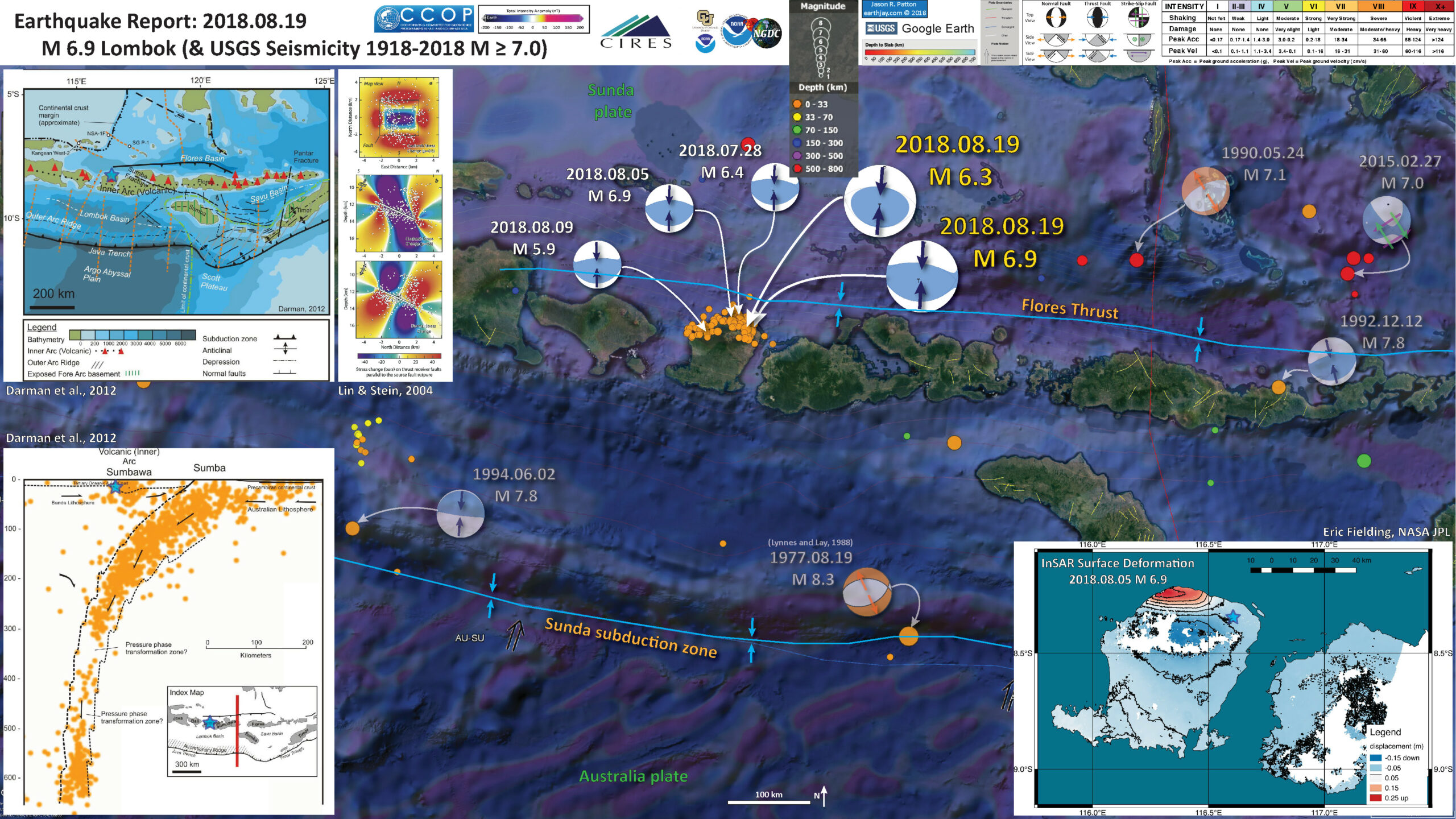
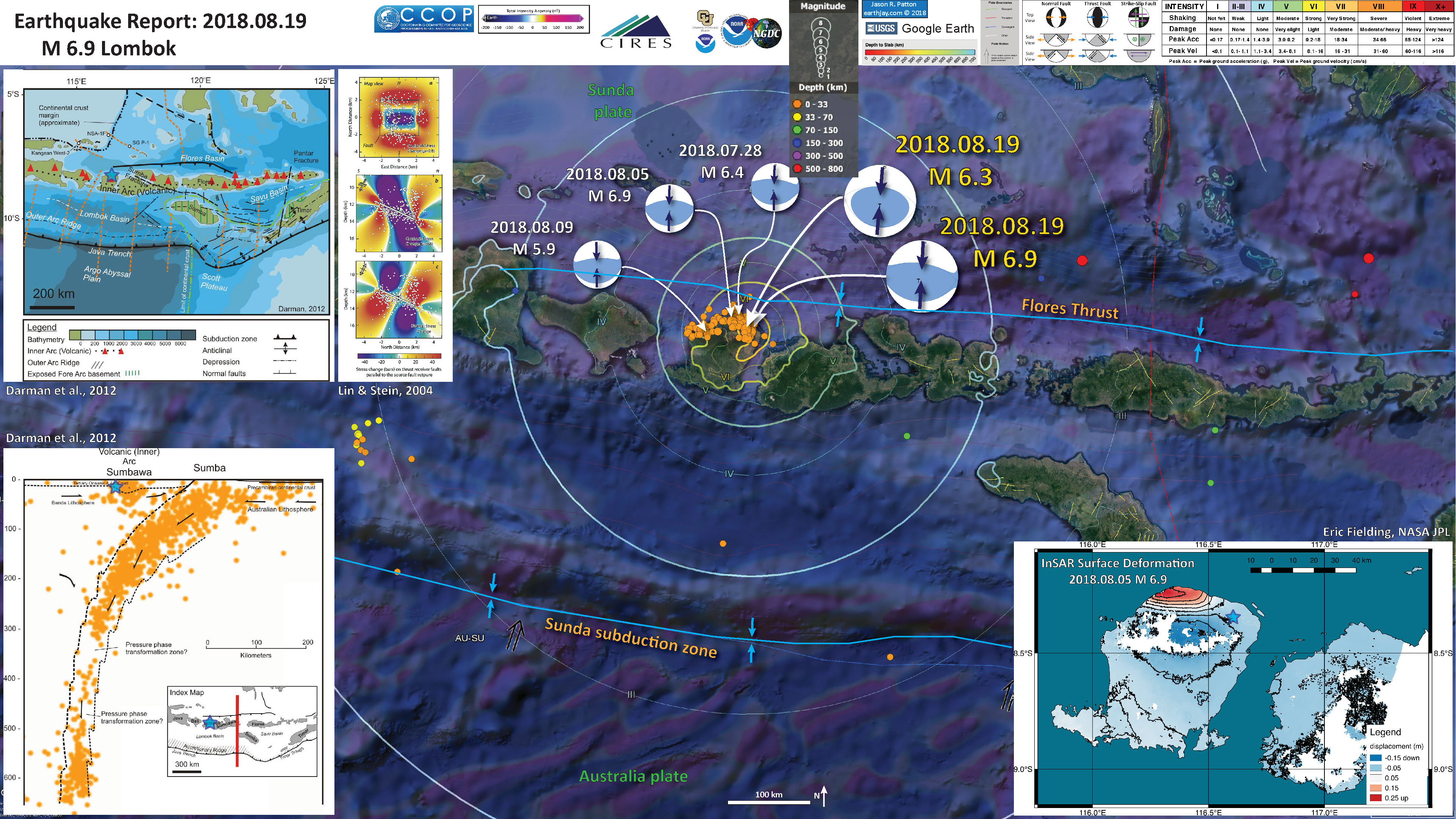
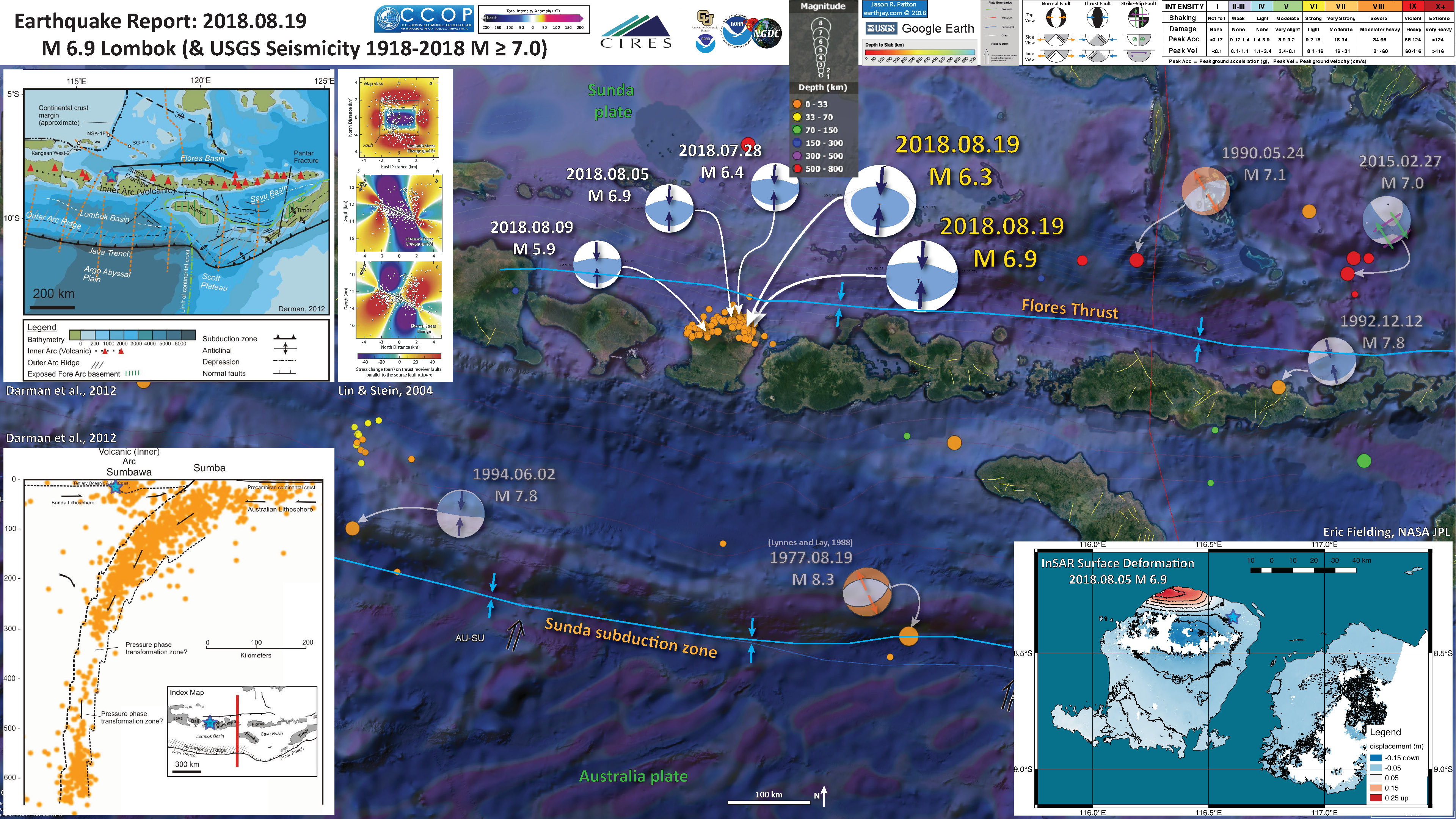
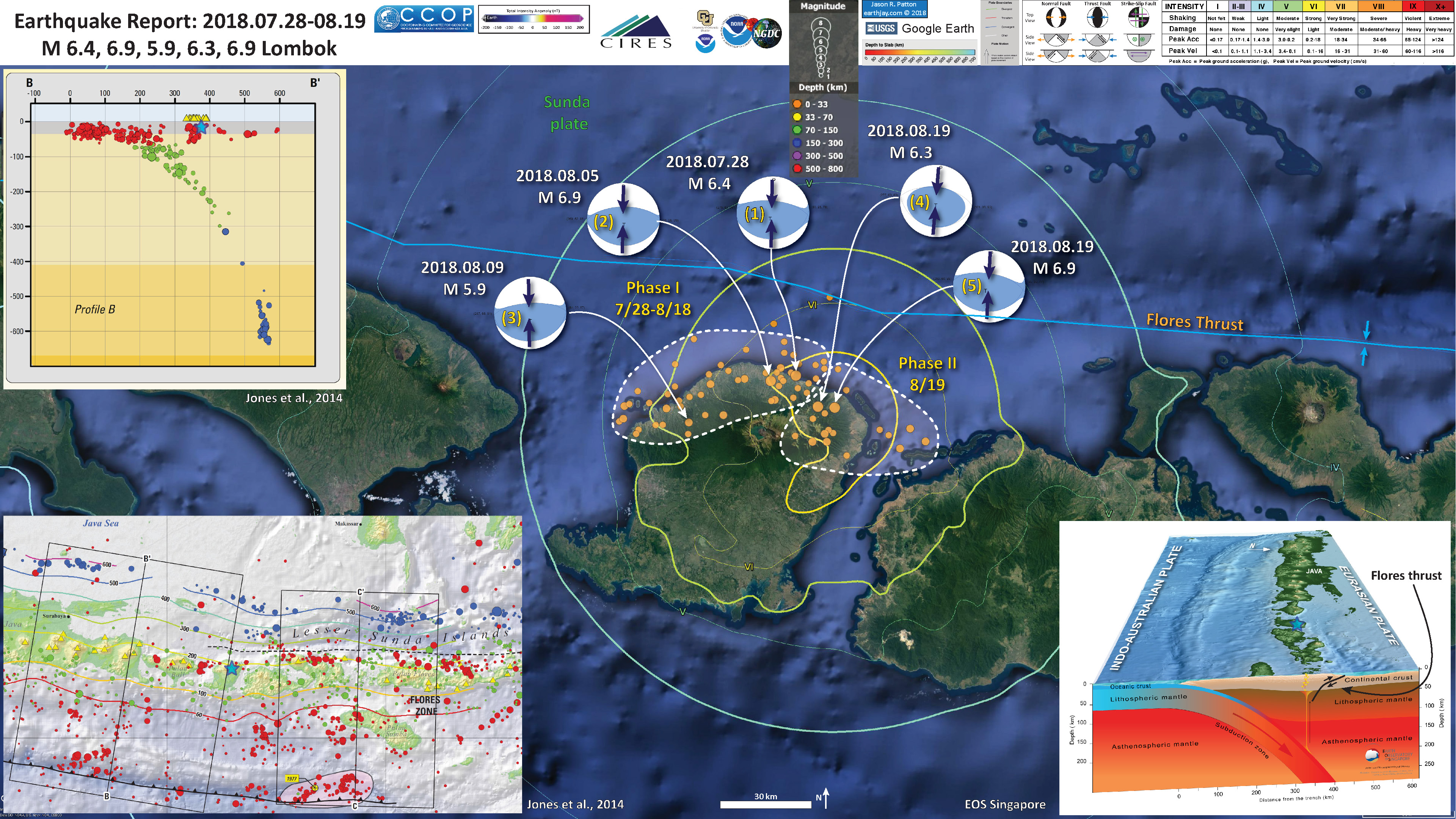
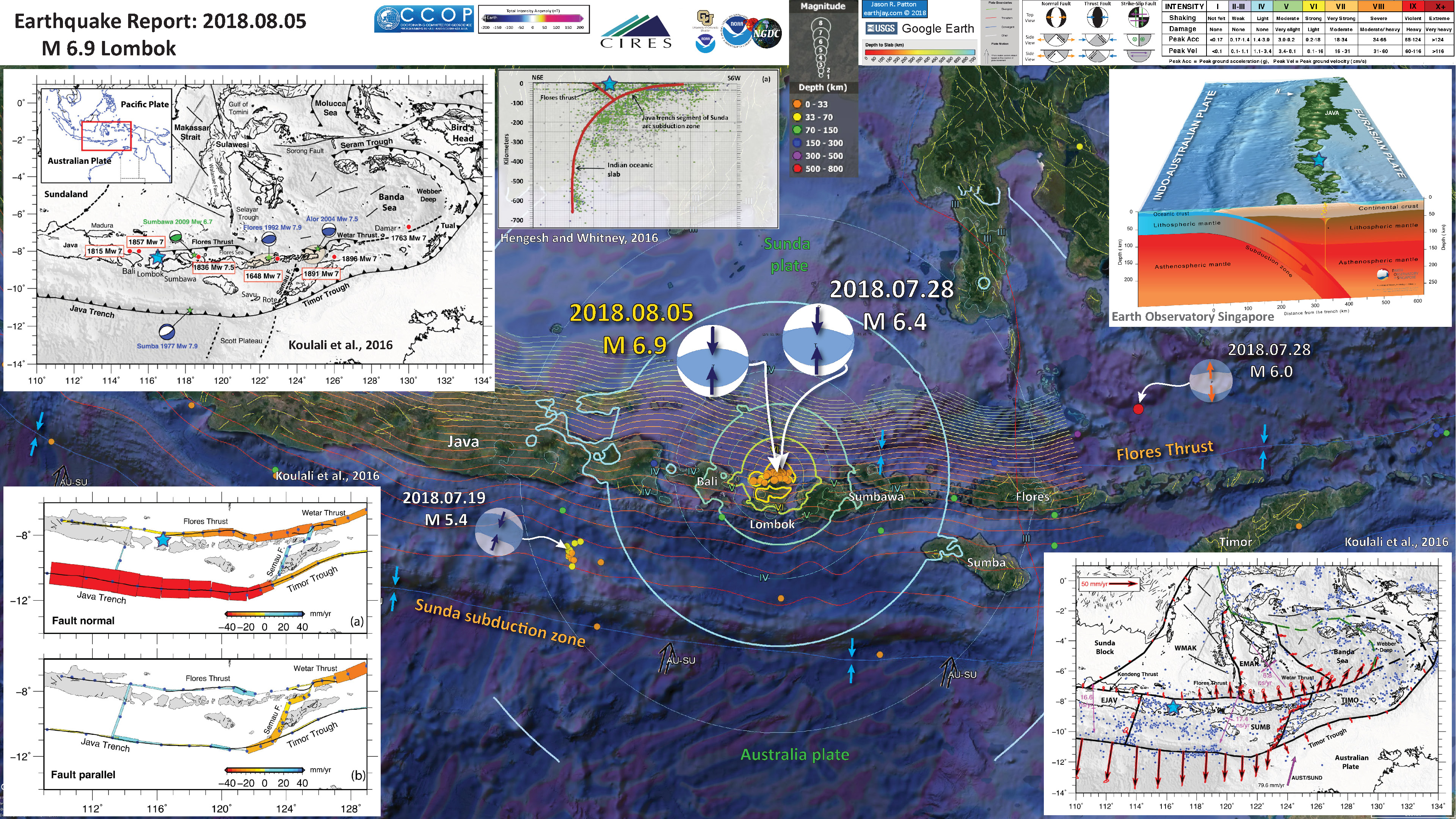

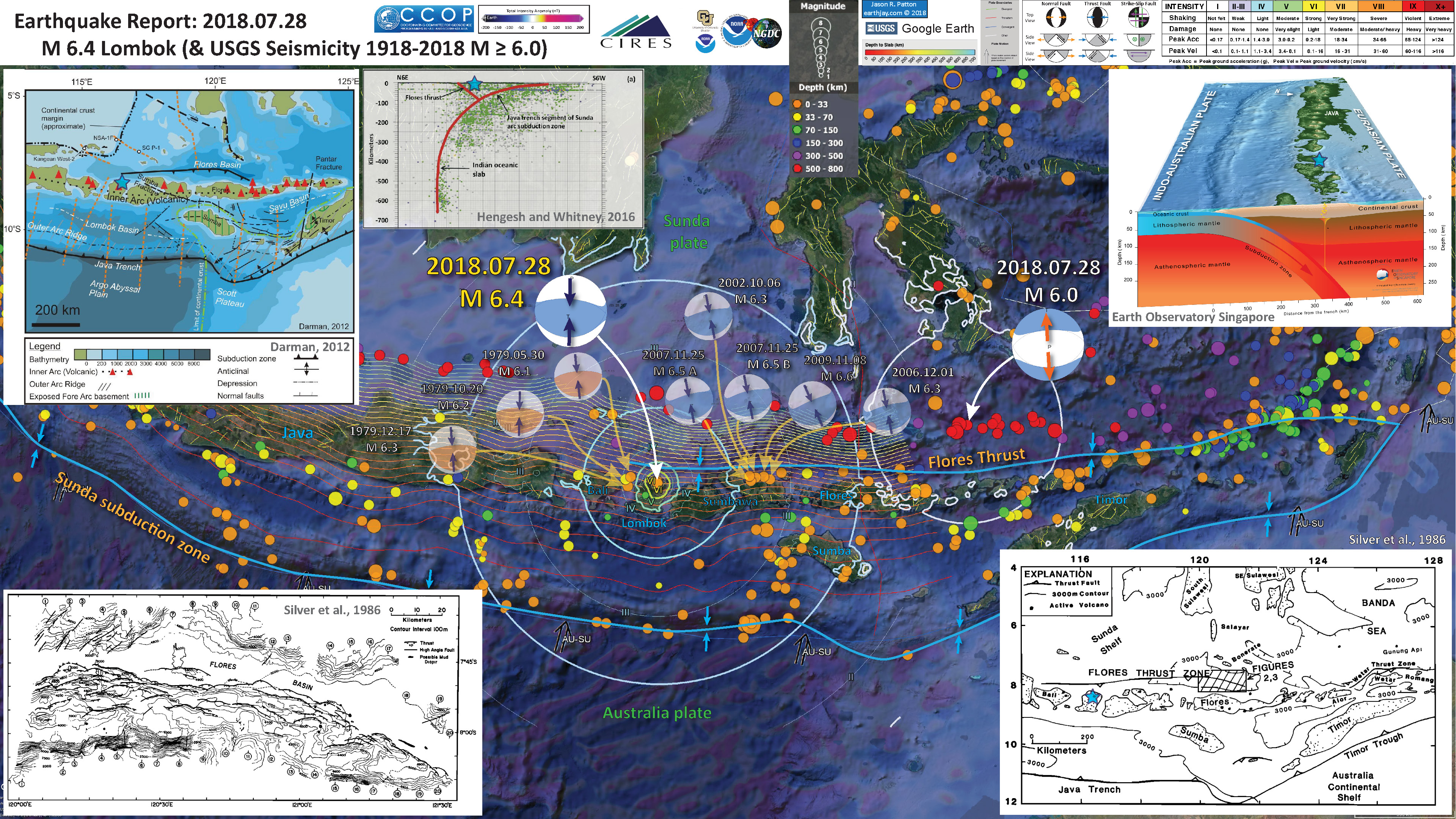
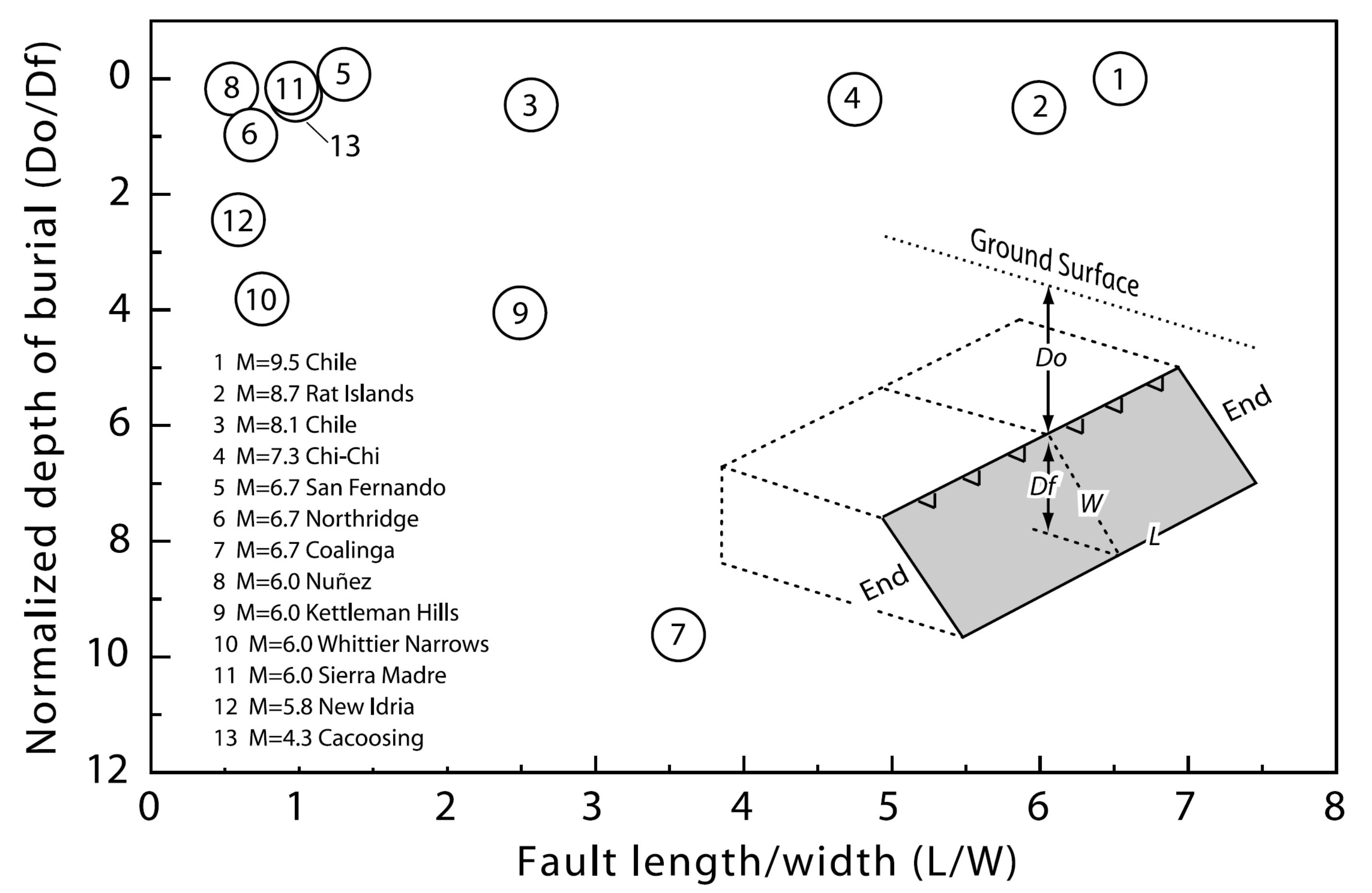
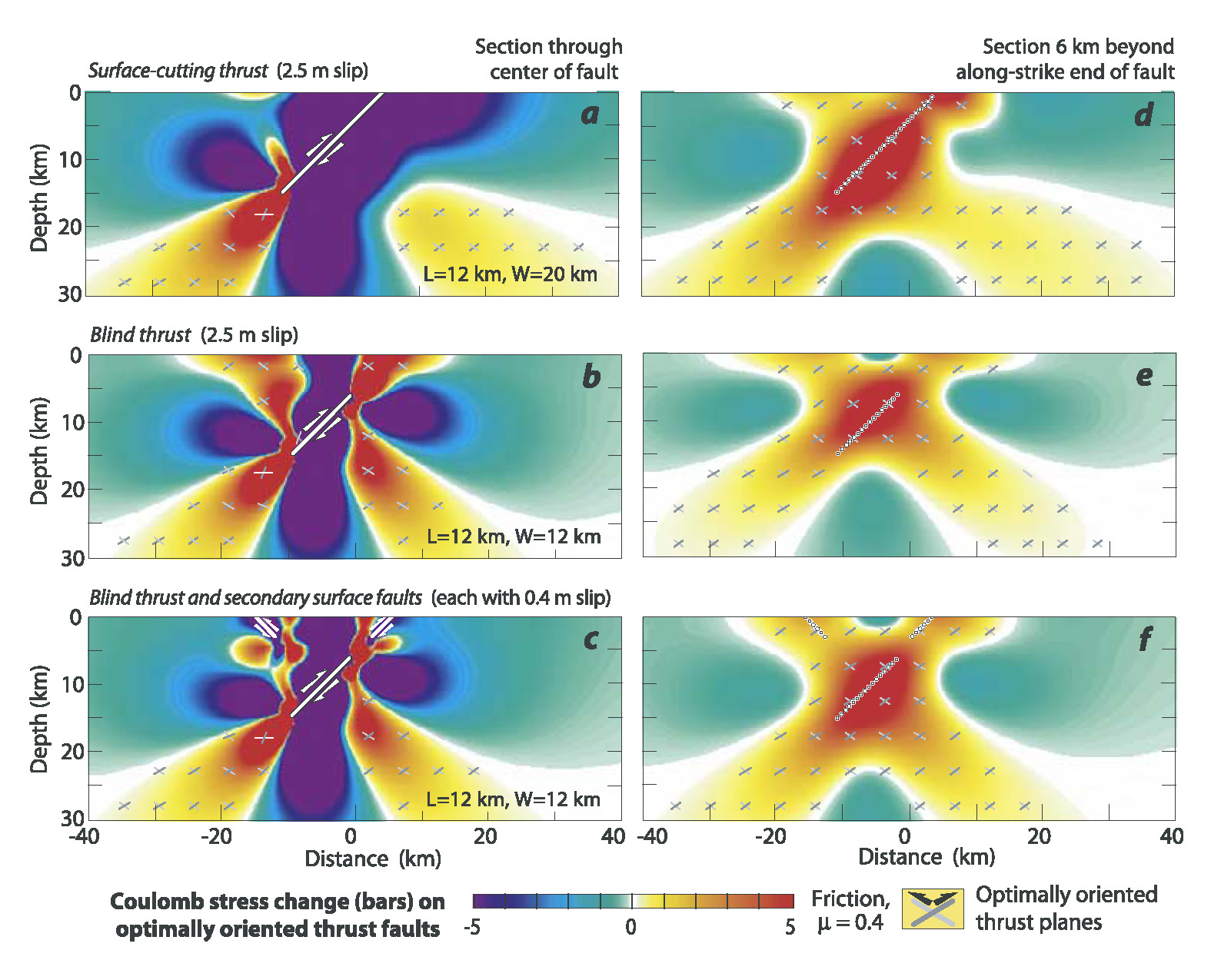

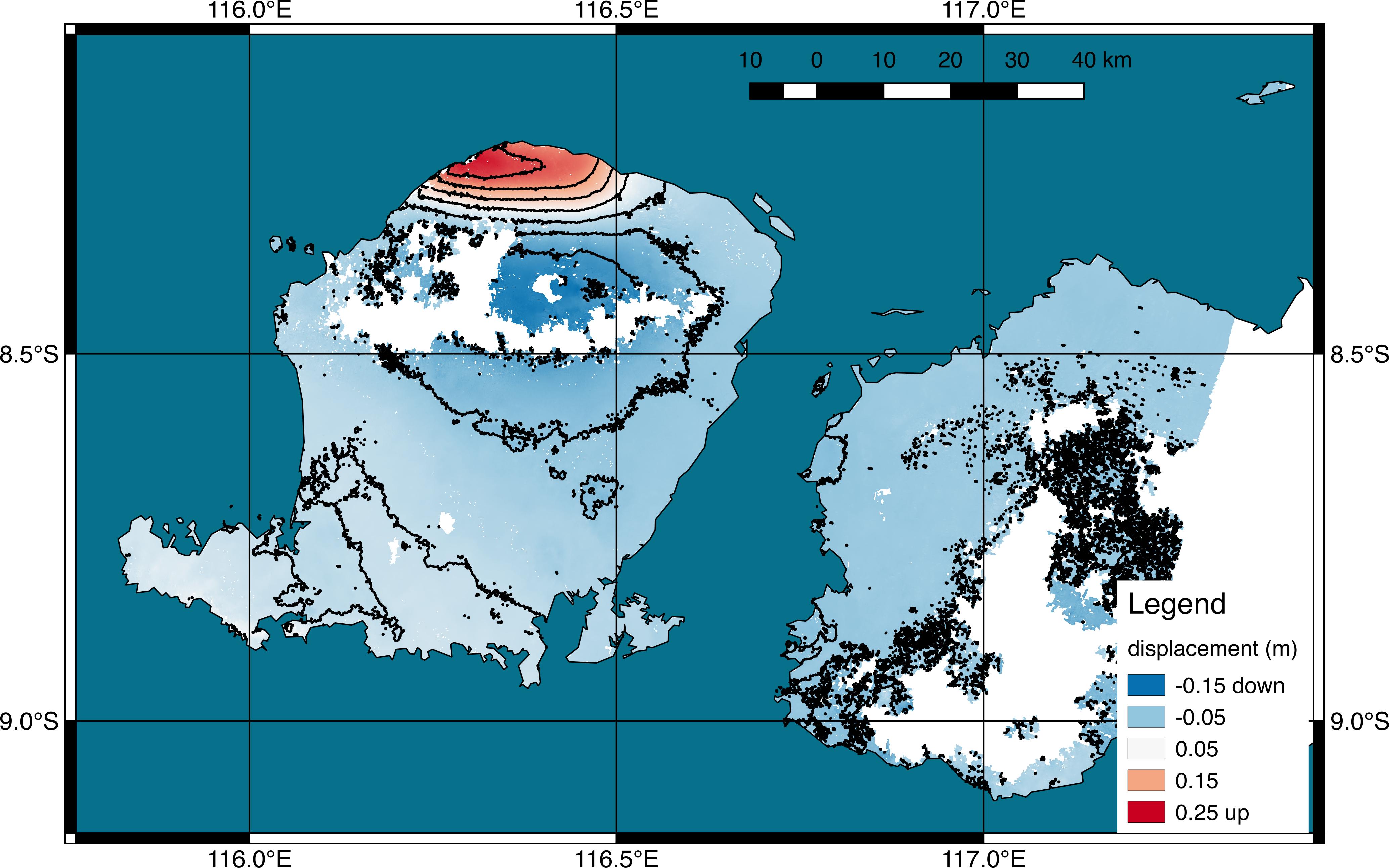


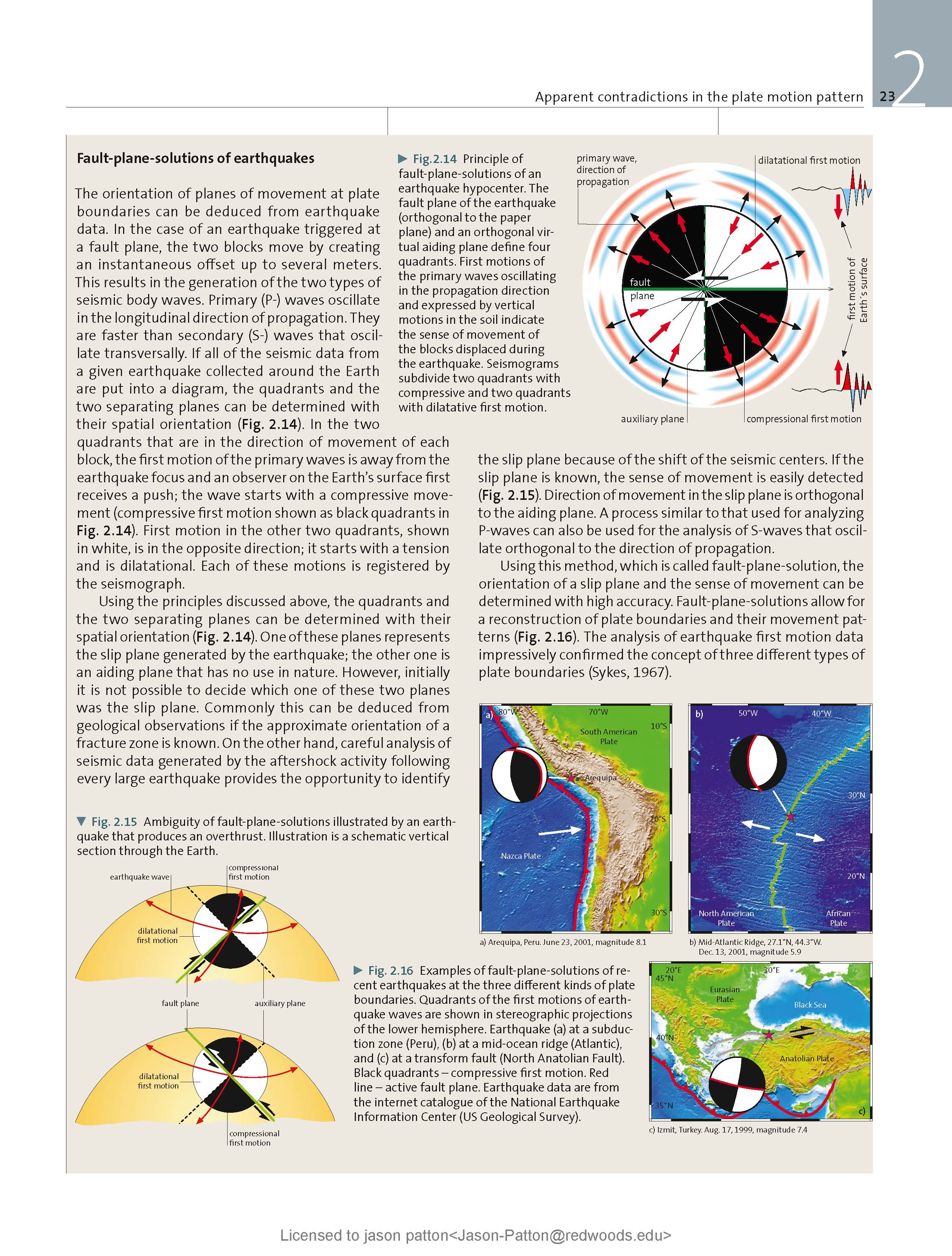
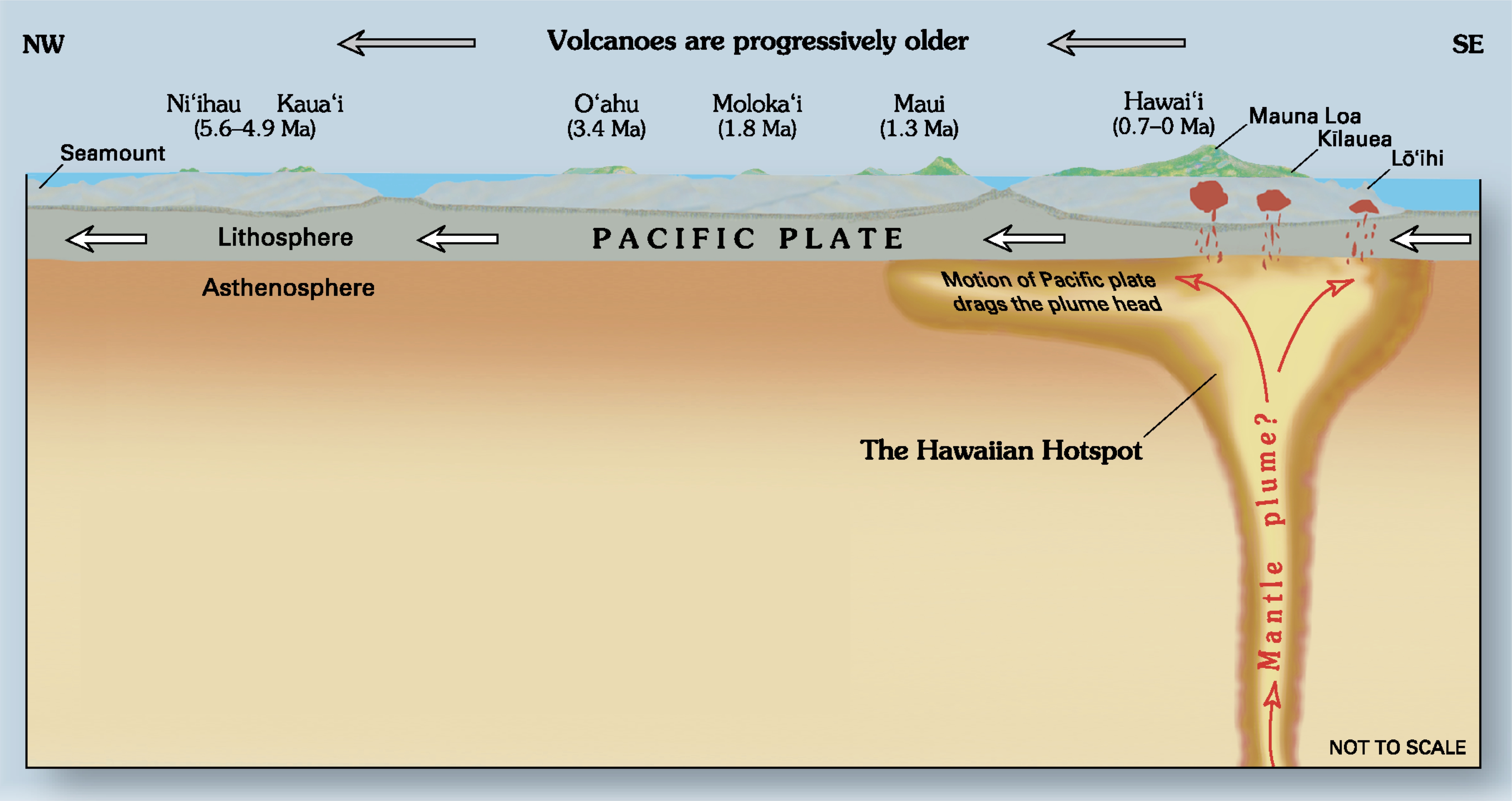
2 thoughts on “Earthquake Report: Lombok, Indonesia”